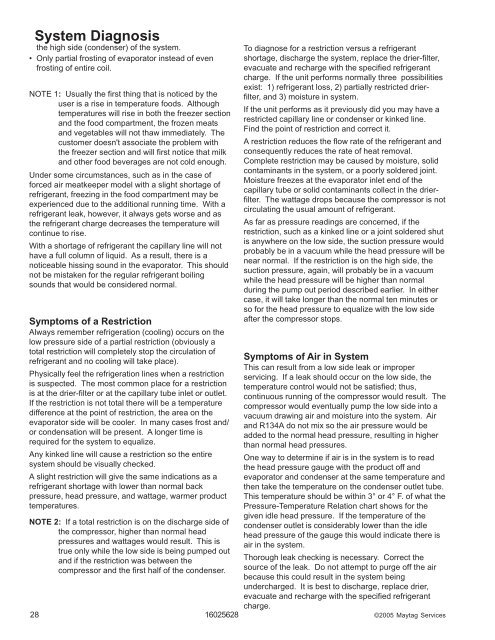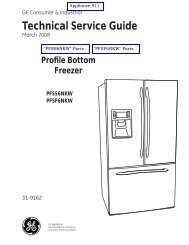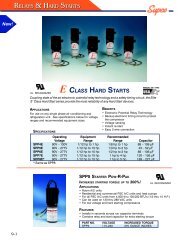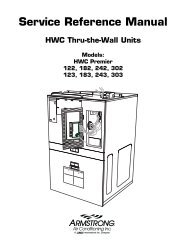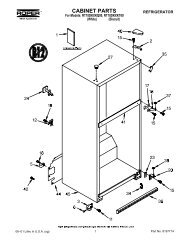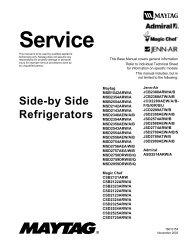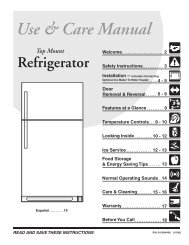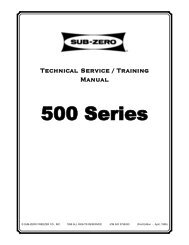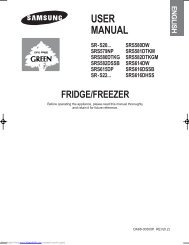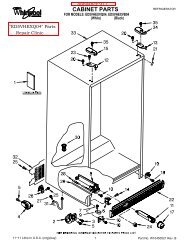ASD2620HE Amana Refrigerator Service Manual - Appliance 911 ...
ASD2620HE Amana Refrigerator Service Manual - Appliance 911 ...
ASD2620HE Amana Refrigerator Service Manual - Appliance 911 ...
Create successful ePaper yourself
Turn your PDF publications into a flip-book with our unique Google optimized e-Paper software.
System Diagnosis<br />
the high side (condenser) of the system.<br />
Only partial frosting of evaporator instead of even<br />
frosting of entire coil.<br />
NOTE 1: Usually the first thing that is noticed by the<br />
user is a rise in temperature foods. Although<br />
temperatures will rise in both the freezer section<br />
and the food compartment, the frozen meats<br />
and vegetables will not thaw immediately. The<br />
customer doesn't associate the problem with<br />
the freezer section and will first notice that milk<br />
and other food beverages are not cold enough.<br />
Under some circumstances, such as in the case of<br />
forced air meatkeeper model with a slight shortage of<br />
refrigerant, freezing in the food compartment may be<br />
experienced due to the additional running time. With a<br />
refrigerant leak, however, it always gets worse and as<br />
the refrigerant charge decreases the temperature will<br />
continue to rise.<br />
With a shortage of refrigerant the capillary line will not<br />
have a full column of liquid. As a result, there is a<br />
noticeable hissing sound in the evaporator. This should<br />
not be mistaken for the regular refrigerant boiling<br />
sounds that would be considered normal.<br />
To diagnose for a restriction versus a refrigerant<br />
shortage, discharge the system, replace the drier-filter,<br />
evacuate and recharge with the specified refrigerant<br />
charge. If the unit performs normally three possibilities<br />
exist: 1) refrigerant loss, 2) partially restricted drierfilter,<br />
and 3) moisture in system.<br />
If the unit performs as it previously did you may have a<br />
restricted capillary line or condenser or kinked line.<br />
Find the point of restriction and correct it.<br />
A restriction reduces the flow rate of the refrigerant and<br />
consequently reduces the rate of heat removal.<br />
Complete restriction may be caused by moisture, solid<br />
contaminants in the system, or a poorly soldered joint.<br />
Moisture freezes at the evaporator inlet end of the<br />
capillary tube or solid contaminants collect in the drierfilter.<br />
The wattage drops because the compressor is not<br />
circulating the usual amount of refrigerant.<br />
As far as pressure readings are concerned, if the<br />
restriction, such as a kinked line or a joint soldered shut<br />
is anywhere on the low side, the suction pressure would<br />
probably be in a vacuum while the head pressure will be<br />
near normal. If the restriction is on the high side, the<br />
suction pressure, again, will probably be in a vacuum<br />
while the head pressure will be higher than normal<br />
during the pump out period described earlier. In either<br />
case, it will take longer than the normal ten minutes or<br />
so for the head pressure to equalize with the low side<br />
after the compressor stops.<br />
Symptoms of a Restriction<br />
Always remember refrigeration (cooling) occurs on the<br />
low pressure side of a partial restriction (obviously a<br />
total restriction will completely stop the circulation of<br />
refrigerant and no cooling will take place).<br />
Physically feel the refrigeration lines when a restriction<br />
is suspected. The most common place for a restriction<br />
is at the drier-filter or at the capillary tube inlet or outlet.<br />
If the restriction is not total there will be a temperature<br />
difference at the point of restriction, the area on the<br />
evaporator side will be cooler. In many cases frost and/<br />
or condensation will be present. A longer time is<br />
required for the system to equalize.<br />
Symptoms of Air in System<br />
This can result from a low side leak or improper<br />
servicing. If a leak should occur on the low side, the<br />
temperature control would not be satisfied; thus,<br />
continuous running of the compressor would result. The<br />
compressor would eventually pump the low side into a<br />
vacuum drawing air and moisture into the system. Air<br />
and R134A do not mix so the air pressure would be<br />
added to the normal head pressure, resulting in higher<br />
than normal head pressures.<br />
Any kinked line will cause a restriction so the entire<br />
system should be visually checked.<br />
One way to determine if air is in the system is to read<br />
the head pressure gauge with the product off and<br />
A slight restriction will give the same indications as a evaporator and condenser at the same temperature and<br />
refrigerant shortage with lower than normal back<br />
then take the temperature on the condenser outlet tube.<br />
pressure, head pressure, and wattage, warmer product This temperature should be within 3° or 4° F. of what the<br />
temperatures.<br />
Pressure-Temperature Relation chart shows for the<br />
NOTE 2: If a total restriction is on the discharge side of<br />
the compressor, higher than normal head<br />
pressures and wattages would result. This is<br />
true only while the low side is being pumped out<br />
and if the restriction was between the<br />
compressor and the first half of the condenser.<br />
given idle head pressure. If the temperature of the<br />
condenser outlet is considerably lower than the idle<br />
head pressure of the gauge this would indicate there is<br />
air in the system.<br />
Thorough leak checking is necessary. Correct the<br />
source of the leak. Do not attempt to purge off the air<br />
because this could result in the system being<br />
undercharged. It is best to discharge, replace drier,<br />
evacuate and recharge with the specified refrigerant<br />
charge.<br />
28 16025628 ©2005 Maytag <strong>Service</strong>s


